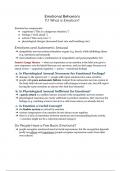Samenvatting
BIOPSYCHOLOGY (Kalat), chapter 11 summary: "Emotional Behaviors"
- Instelling
- Rijksuniversiteit Groningen (RuG)
A well-organized summary of the 11th chapter of Kalat's book "Biopsychology". This chapter covers important information about emotions and the biological base behind it. I recommend this summary to people who had a difficult time with the chapter and need a better overview of its key elements.
[Meer zien]





